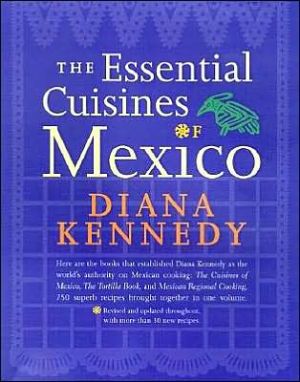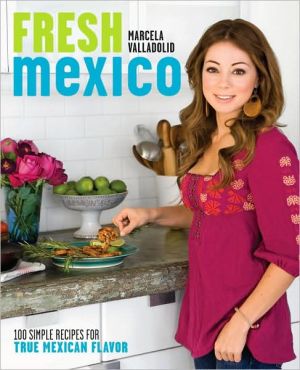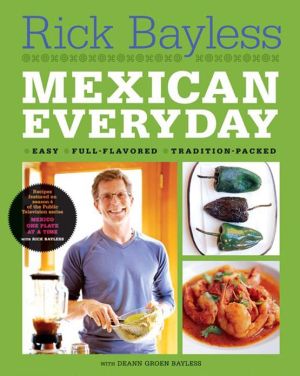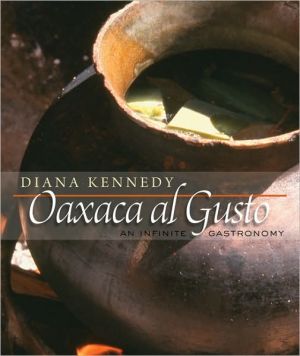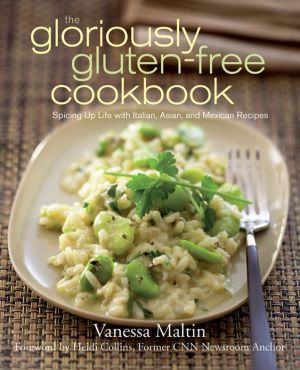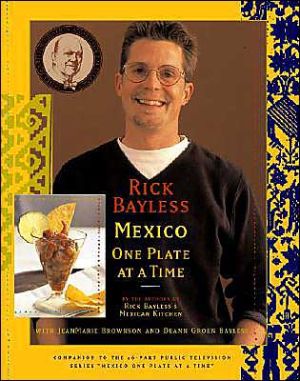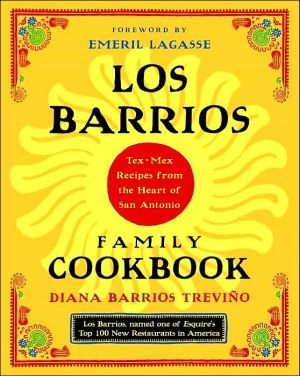Essential Cuisines of Mexico: Revised and Updated Throughout, with More Than 30 New Recipes
More than twenty-five years ago, when Diana Kennedy published The Cuisines of Mexico, knowledge and appreciation of authentic Mexican cooking were in their infancy. But change was in the air. Home cooks were turning to Julia Child for an introduction to French cuisine and to Marcella Hazan for the tastes of Italy. Through Diana Kennedy they discovered a delicious and highly developed culinary tradition they barely knew existed. The Cuisines of Mexico, Mexican Regional Cooking, and The...
Search in google:
More than twenty-five years ago, when Diana Kennedy published The Cuisines of Mexico, knowledge and appreciation of authentic Mexican cooking were in their infancy. But change was in the air. Home cooks were turning to Julia Child for an introduction to French cuisine and to Marcella Hazan for the tastes of Italy. Through Diana Kennedy they discovered a delicious and highly developed culinary tradition they barely knew existed. The Cuisines of Mexico, Mexican Regional Cooking, and The Tortilla Book became best-sellers, and Diana Kennedy was recognized as the authority on Mexican food.Now a new generation has discovered that Mexican food is more than chimichangas, that they can find fresh hierbas de olor (pot herbs, including marjoram and Mexican bayleaf) and chilacas in their markets. The book that will become indispensable in their kitchens is The Essential Cuisines of Mexico.Diana has combined her three classic books in one volume, refining recipes when possible, bringing them up to date without losing the spirit of their generation. Old friends will be delighted to revisit these refreshed classics and to find more than thirty new recipes from different regions of Mexico. Among these discoveries are the very popular arroz a la tumbada (rice with seafood) from Veracruz, a pico de gallo with peaches from the state of Mexico, and tasty snacks from the cantinas of Mérida. Newcomers will delight in Diana's "word pictures" — descriptions of her travels and discoveries — and in her off-the-cuff comments. Whether they turn to this book for the final word on tamales, recipes for tasty antojitos to serve with drinks, or superb tacos, they will find there is no better teacher of Mexican food. How enviable to attempt for the first time Calzones del Diablo (yes, the Devil's Pants), and what a pleasure to succumb to Diana's passion for Mexican food. Publishers Weekly HThe prolific Kennedy revisits her adopted homeland in The Essential Cuisines of Mexico, a compilation of her first three books (The Cuisines of Mexico, The Tortilla Book and Mexican Regional Cooking). From Nuevo Le n to the Yucatan, Kennedy strives to retain the authenticity of regional recipes: "I have simplified the recipes when possible, bringing them up to date without losing the spirit of their generation." Chapters reflect an assemblage of courses, including appetizers, corn dough cakes, vegetables, meats, egg dishes, light meals, sauces and relishes, sweet pastries and drinks. The concluding "general information" section provides helpful tips on equipment, chiles, cheeses, spices, herbs and other ingredients indigenous to Mexican cookery. Chapter introductions and detailed anecdotes (e.g., "A Weekend and Barbecue in Oaxaca") offer engaging glimpses of local Mexican life. Recipes will beguile aficionados searching for the "real Mexican deal," with a cornucopia of earthy ingredients--like calf's tongue, pig's feet, tripe "of different textures," pork lard--and exotic flavors, such as machaca (dried salted beef), nopoles (cactus paddles) and cuiclacoche (corn fungus). For novices, there are appealing, easy-to-make comfort foods, like Angel Hair Pasta in Tomato Broth and Chiles Con Queso (Chiles with Cheese), while seasoned cooks will appreciate challenging dishes such as Stuffed Chiles in Walnut Sauce and Turkey in Mole Poblana. Vivid prose chronicles the sojourns of Kennedy's curious palate, painting "word pictures" to describe "a Mexico of the past." Her efforts yield yet another classic, one that masterfully documents the rich diversity of Mexico's gastronomic heritage. (Sept.) Copyright 2000 Cahners Business Information.
I am sure that this reincarnation of old friends will reach a new audience as future generations of Mexican Americans become more aware of their culinary heritage and a new wave of young chefs delves into these exciting, authentic recipes. Among them, I am sure, will be my devoted fans, to whom I am so grateful for their continued enthusiasm for my books and classes, and for their letters of appreciation, which I have carefully saved over the years. They, too, have helped preserve the spirit of these fascinating cuisines.\ Guacamole Avacado Dip Makes about 2 1/3 cups (585 ML)\ The word guacamole comes from the Nahuatl words for "avocado" (ahuacatl) and "mixture," or "concoction" (molli) — and what a beautiful "concoction" guacamole is, pale green sparked with the cilantro's darker green and the red of the tomato. Its beauty is definitely enhanced if it is served in the molcajete in which it has been made and where it rightfully belongs. (Never, never use a blender for the avocado to turn it into one of those smooth, homogeneous messes!) If you don't possess a molcajete, then use a blender for the base ingredients and mash avocados into it.\ Guacamole is usually eaten in Mexico at the beginning of a meal with a pile of hot, freshly made tortillas or with other botanas (snacks), like crisp pork skins (chicharrón) or little pieces of crispy pork (carnitas). It will also often accompany a plate of tacos. It is so delicate that it is best eaten the moment it is prepared. There are many suggestions for keeping it — covering it airtight, leaving the pit in, and so forth — but they will help only for a brief time; almost immediately the delicate green will darken and the fresh, wonderful flavor will be lost.\ 2 tablespoons finely chopped white onion\ 4 serrano chiles, or to taste, finely chopped\ 3 heaped tablespoons roughly chopped cilantro Salt to taste\ 3 large avocados (about 1 pound, 6 ounces/630 G)\ 4 ounces (115 G) tomatoes, finely chopped (About 2/3 Cup/165 ML)\ To Serve\ 1 heaped tablespoon finely chopped onion\ 2 heaped tablespoons roughly chopped cilantro\ Grind together the onion, chiles, cilantro, and salt to a paste.\ Cut the avocados into halves, remove the pits, and squeeze the flesh out of the shell and mash into the chile base to a textured consistency — it should not be smooth. Stir in all but 1 tablespoon of the tomatoes, onion, and cilantro, adjust seasoning, and top with the remaining chopped tomatoes, onion, and cilantro.\ Serve immediately at room temperature (see note above). I do not recommend freezing.
AcknowledgmentsxiIntroductionxiiForewordxviPrefacexviiAppetizers1Masa Fantasies25Tortillas and Tortilla Dishes44Tamales95Soups115Soup Stews138Beans, Rice, and Pasta151Egg Dishes169Light Meals181Salads194Vegetables205Sauces and Relishes234Meats252Pork256Beef287Assorted Meats297Poultry323Seafood354Sweet Yeast Breads389Desserts and Cookies408Drinks443General Information459Sources501Index502
\ Publishers Weekly - Publisher's Weekly\ HThe prolific Kennedy revisits her adopted homeland in The Essential Cuisines of Mexico, a compilation of her first three books (The Cuisines of Mexico, The Tortilla Book and Mexican Regional Cooking). From Nuevo Le n to the Yucatan, Kennedy strives to retain the authenticity of regional recipes: "I have simplified the recipes when possible, bringing them up to date without losing the spirit of their generation." Chapters reflect an assemblage of courses, including appetizers, corn dough cakes, vegetables, meats, egg dishes, light meals, sauces and relishes, sweet pastries and drinks. The concluding "general information" section provides helpful tips on equipment, chiles, cheeses, spices, herbs and other ingredients indigenous to Mexican cookery. Chapter introductions and detailed anecdotes (e.g., "A Weekend and Barbecue in Oaxaca") offer engaging glimpses of local Mexican life. Recipes will beguile aficionados searching for the "real Mexican deal," with a cornucopia of earthy ingredients--like calf's tongue, pig's feet, tripe "of different textures," pork lard--and exotic flavors, such as machaca (dried salted beef), nopoles (cactus paddles) and cuiclacoche (corn fungus). For novices, there are appealing, easy-to-make comfort foods, like Angel Hair Pasta in Tomato Broth and Chiles Con Queso (Chiles with Cheese), while seasoned cooks will appreciate challenging dishes such as Stuffed Chiles in Walnut Sauce and Turkey in Mole Poblana. Vivid prose chronicles the sojourns of Kennedy's curious palate, painting "word pictures" to describe "a Mexico of the past." Her efforts yield yet another classic, one that masterfully documents the rich diversity of Mexico's gastronomic heritage. (Sept.) Copyright 2000 Cahners Business Information.\ \ \ \ \ Library JournalKennedy has been writing about Mexican food for more than 30 years and is widely acknowledged as the authority on the topic. Her last book was My Mexico (LJ 9/15/98), a personal culinary journal through the country and its regional cuisines. Now she has gathered the recipes from her first cookbook, the groundbreaking Cuisines of Mexico (1972), as well its two successors, The Tortilla Book (1975) and Mexican Regional Cooking (1978), both of which are out of print, in this new collection. She's revised the recipes and simplified some, and there are also 30 or so new recipes. Kennedy's books became classics long ago; this compilation of her early works is an essential purchase. Copyright 2000 Cahners Business Information.\\\ \
